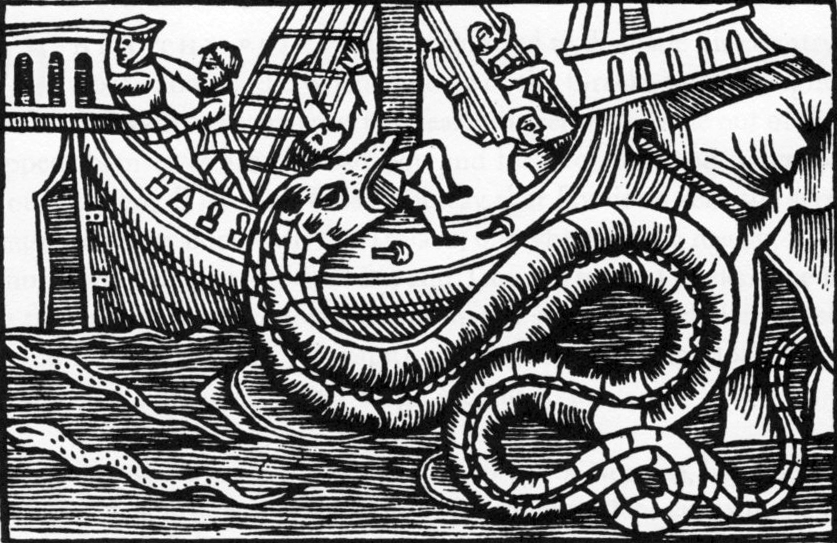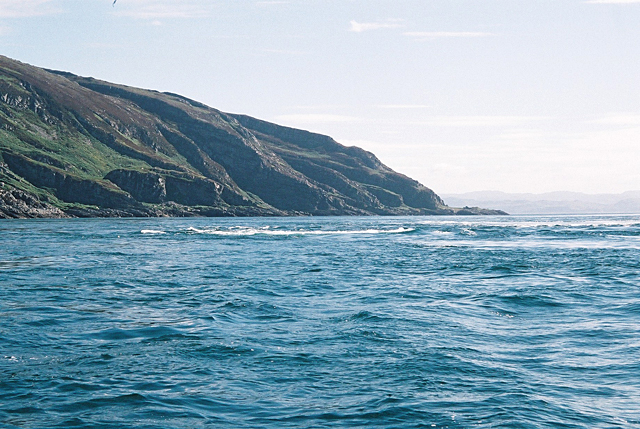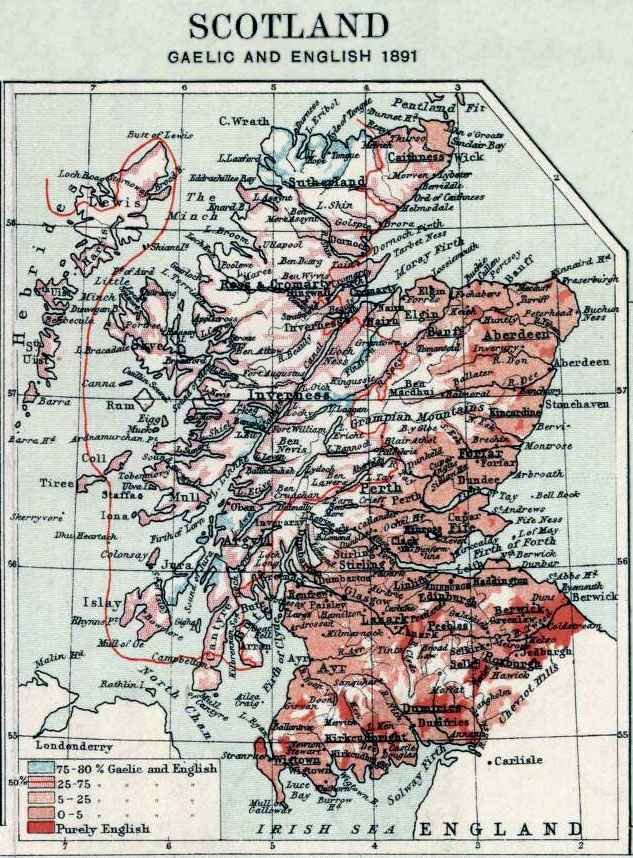|
Cirein-cròin
Ceirean,Forbes p7; Dwelly Cirein-cròin or cionarain-crò was a large sea monster in Scottish Gaelic folklore. An old saying claims that it was so large that it fed on seven whales: Local folklores say this huge animal can disguise itself as a small silver fish when fishermen came in contact with it. Other accounts state the reason for the disguise was to attract its next meal; when the fisherman would catch it in its small silver fish form, once aboard it changed back to the monster and ate him. A saying, as recorded by Alexander Robert Forbes, goes: A second version of the saying maintains the first two lines, but changes the later parts and ranks the "Cionarain-cro" second to the "great sea animal". In ''Carmina Gadelica'', Alexander Carmichael attested this version to a cottar named Kenneth Morrison, in Trithion, on the Isle of Skye, from whom it was recorded in 1860. Forbes identifies the creature as a large sea serpent, but this is arguable. He also proposes it as a di ... [...More Info...] [...Related Items...] OR: [Wikipedia] [Google] [Baidu] |
Sea Monster
Sea monsters are beings from folklore believed to dwell in the sea and are often imagined to be of immense size. Marine monsters can take many forms, including sea dragons, sea serpents, or tentacled beasts. They can be slimy and scaly and are often pictured threatening ships or spouting jets of water. The definition of a "monster" is subjective; further, some sea monsters may have been based on scientifically accepted creatures, such as whales and types of giant squid, giant and colossal squid. Sightings and legends Sea monster accounts are found in virtually all cultures that have contact with the sea. For example, Avienius relates of Himilco the Navigator, Carthaginian explorer Himilco's voyage "...there monsters of the deep, and beasts swim amid the slow and sluggishly crawling ships." (lines 117–29 of ''Ora Maritima''). Humphrey Gilbert, Sir Humphrey Gilbert claimed to have encountered a lion-like monster with "glaring eyes" on his return voyage after formally claiming ... [...More Info...] [...Related Items...] OR: [Wikipedia] [Google] [Baidu] |
Sea Serpent
A sea serpent is a type of sea monster described in various mythologies, most notably in Mesopotamian cosmology (Tiamat), Ugaritic cosmology ( Yam, Tannin), biblical cosmology (Leviathan, Rahab), Greek cosmology (Cetus, Echidna, Hydra, Scylla), and Norse cosmology (Jörmungandr). Mythology Mediterranean and Western Asia The mytheme, the chief god in the role of the hero slaying a sea serpent, is widespread both in the ancient Near East and in Indo-European mythology, e.g. Lotan and Hadad, Leviathan and Yahweh, Tiamat and Marduk (see also Labbu, Bašmu, Mušḫuššu), Illuyanka and Tarhunt, Yammu and Baal in the Baal Cycle etc. The Hebrew Bible also has mythological descriptions of large sea creatures as part of creation under Yahweh's command, such as the Tanninim mentioned in Book of Genesis 1:21 and the "great serpent" of Amos 9:3. In the Aeneid, a pair of sea serpents killed Laocoön and his sons when Laocoön argued against bringing the Trojan Horse into Tr ... [...More Info...] [...Related Items...] OR: [Wikipedia] [Google] [Baidu] |
Mythological Aquatic Creatures
Myth is a genre of folklore consisting primarily of narratives that play a fundamental role in a society. For scholars, this is very different from the vernacular usage of the term "myth" that refers to a belief that is not true. Instead, the veracity of a myth is not a defining criterion. Myths are often endorsed by religious (when they are closely linked to religion or spirituality) and secular authorities. Many societies group their myths, legends, and history together, considering myths and legends to be factual accounts of their remote past. In particular, creation myths take place in a primordial age when the world had not achieved its later form. Origin myths explain how a society's customs, institutions, and taboos were established and sanctified. National myths are narratives about a nation's past that symbolize the nation's values. There is a complex relationship between recital of myths and the enactment of rituals. Etymology The word "myth" comes from Ancient G ... [...More Info...] [...Related Items...] OR: [Wikipedia] [Google] [Baidu] |
Scottish Folklore
Scottish folklore (Scottish Gaelic: ''Beul-aithris na h-Alba'') encompasses the folklore of the Scottish people from their earliest records until today. Folkloristics, Folklorists, both academic and amateur, have published a variety of works focused specifically on the area over the years.Sanderson (1957: 457-466). Some creatures of Scottish folklore are Loch Ness Monster, brownie (folklore), brownies, bogles, kelpies, selkies, wulver, the wulver, bean-nighe, the bean-nighe, and Blue men of the Minch, the blue men of the Minch. See also * Cornish mythology * English folklore * Matter of Britain * Welsh folklore * Welsh mythology * Scottish mythology Notes References * External links * Scottish folklore, {{Folklore-stub ... [...More Info...] [...Related Items...] OR: [Wikipedia] [Google] [Baidu] |
Scottish Mythology
Scottish mythology is the collection of myths that have emerged throughout the history of Scotland, sometimes being elaborated upon by successive generations, and at other times being rejected and replaced by other explanatory narratives. Nature myths The myths and legends of Scotland have a "local colour" as they tell about the way of life during the olden times, apart from giving a perspective of the nature of the country during various seasons of the year. It was the belief that Beira, the Queen of Winter, had a firm hold on the country by raising storms during January and February thus preventing greenery to emerge. She was considered a tough and brutal old woman who stirred the deadly spiraling action of Corryvreckan, ushering snow, as well as torrents resulting in the overflow of rivers. Even the creation of lochs and mountains were attributed to her. Scottish mythology is not like the Greek and Roman myths as it deals with various aspects of nature. In this conte ... [...More Info...] [...Related Items...] OR: [Wikipedia] [Google] [Baidu] |
Scottish Gaelic Language
Scottish Gaelic (, ; Endonym and exonym, endonym: ), also known as Scots Gaelic or simply Gaelic, is a Celtic language native to the Gaels of Scotland. As a member of the Goidelic language, Goidelic branch of Celtic, Scottish Gaelic, alongside both Irish language, Irish and Manx language, Manx, developed out of Old Irish. It became a distinct spoken language sometime in the 13th century in the Middle Irish period, although a Classical Gaelic, common literary language was shared by the Gaels of both Ireland and Scotland until well into the 17th century. Most of modern Scotland was once Gaelic-speaking, as evidenced especially by Gaelic-language place names. In the 2011 United Kingdom census#2011 Census for Scotland, 2011 census of Scotland, 57,375 people (1.1% of the Scottish population, three years and older) reported being able to speak Gaelic, 1,275 fewer than in 2001. The highest percentages of Gaelic speakers were in the Outer Hebrides. Nevertheless, there is a language ... [...More Info...] [...Related Items...] OR: [Wikipedia] [Google] [Baidu] |
Stoor Worm
The stoor worm, or Mester Stoor Worm, was a gigantic evil sea serpent of Orcadian folklore, capable of contaminating plants and destroying animals and humans with its putrid breath. It is probably an Orkney variant of the Norse Jörmungandr, also known as the Midgard Serpent, or world serpent, and has been described as a sea dragon. The king of one country threatened by the beast's arrival was advised to offer it a weekly sacrifice of seven virgins. In desperation, the king eventually issued a proclamation offering his kingdom, his daughter's hand in marriage, and a magic sword to anyone who could destroy the monster. Assipattle, the youngest son of a local farmer, defeated the creature; as it died its teeth fell out to become the islands of Orkney, Shetland and the Faroes, and its body became Iceland. Similarities between Assipatle's defeat of the monster and other dragon-slayer tales, including Herakles' destruction of a sea monster to save Hesione, have been noted by sever ... [...More Info...] [...Related Items...] OR: [Wikipedia] [Google] [Baidu] |
Jörmungandr
In Norse mythology, Jörmungandr (, see Etymology), also known as the Midgard Serpent or World Serpent (, "worm of Midgard"), is an unfathomably large and monstrous sea serpent or worm who dwells in the world sea, encircling the Earth ( Midgard) and biting its own tail, an example of an ouroboros. As a result of him surrounding Midgard, the beast is referred to as the World Serpent. Jörmungandr releasing his tail is one of the signs of the beginning of Ragnarök. Jörmungandr is said to be the middle child of the god Loki and the jötunn Angrboða. According to the ''Prose Edda'', Odin took Loki's three children by Angrboða – the wolf Fenrir, underworld ruler Hel, and the serpent Jörmungandr – and removed them from Asgard (the world of the Æsir). The serpent Jörmungandr was tossed into the great ocean that encircles Midgard.Snorri Sturluson; Brodeur, Arthur Gilchrist (trans.) (1916). '' The Prose Edda''. New York: The American-Scandinavian Foundation. '' Gyl ... [...More Info...] [...Related Items...] OR: [Wikipedia] [Google] [Baidu] |
Atlantosaurus
''Atlantosaurus'' (meaning "Atlas lizard") is a dubious genus of sauropod dinosaur. It contains a single species, ''Atlantosaurus montanus'', from the upper Morrison Formation of Colorado, United States. ''Atlantosaurus'' was the first sauropod to be described during the infamous 19th century Bone Wars,Wilson, J. A. (2011). "Anatomical terminology for the sacrum of sauropod dinosaurs." ''Contributions from the Museum of Paleontology, University of Michigan'', 32(5): 59-69/ref> during which scientific methodology suffered in favor of pursuit of academic acclaim. History The type species, type specimen, YPM 1835, found by Arthur Lakes in Lakes Quarry Number 1 in the Morrison Formation of Colorado, United States, was named and described by Othniel Charles Marsh, Professor of Paleontology at Yale University (then called ''Yale College''), in July 1877 as ''Titanosaurus montanus''. Marsh soon learned that the name ''Titanosaurus'' had already been used earlier that year by Richard L ... [...More Info...] [...Related Items...] OR: [Wikipedia] [Google] [Baidu] |
Dinosaurs
Dinosaurs are a diverse group of reptiles of the clade Dinosauria. They first appeared during the Triassic Geological period, period, between 243 and 233.23 million years ago (mya), although the exact origin and timing of the #Evolutionary history, evolution of dinosaurs is a subject of active research. They became the dominant terrestrial vertebrates after the Triassic–Jurassic extinction event 201.3 mya and their dominance continued throughout the Jurassic and Cretaceous periods. The fossil record shows that birds are feathered dinosaurs, Evolution of birds, having evolved from earlier Theropoda, theropods during the Late Jurassic epoch, and are the only dinosaur lineage known to have survived the Cretaceous–Paleogene extinction event approximately 66 mya. Dinosaurs can therefore be divided into avian dinosaurs—birds—and the extinct non-avian dinosaurs, which are all dinosaurs other than birds. Dinosaurs are varied from taxonomy (biology), taxonomic, ... [...More Info...] [...Related Items...] OR: [Wikipedia] [Google] [Baidu] |
Sperm Whale
The sperm whale or cachalot (''Physeter macrocephalus'') is the largest of the toothed whales and the largest toothed predator. It is the only living member of the Genus (biology), genus ''Physeter'' and one of three extant species in the sperm whale superfamily Physeteroidea, along with the pygmy sperm whale and dwarf sperm whale of the genus ''Kogia''. The sperm whale is a pelagic mammal with a worldwide range, and will migrate seasonally for feeding and breeding. Females and young males live together in groups, while mature males (bulls) live solitary lives outside of the mating season. The females cooperate to protect and Lactation, nurse their young. Females give birth every four to twenty years, and care for the calves for more than a decade. A mature, healthy sperm whale has no natural predators, although calves and weakened adults are sometimes killed by Cetacea#Social relations, pods of killer whales (orcas). Mature males average in length, with the head represent ... [...More Info...] [...Related Items...] OR: [Wikipedia] [Google] [Baidu] |
Scottish Gaelic
Scottish Gaelic (, ; Endonym and exonym, endonym: ), also known as Scots Gaelic or simply Gaelic, is a Celtic language native to the Gaels of Scotland. As a member of the Goidelic language, Goidelic branch of Celtic, Scottish Gaelic, alongside both Irish language, Irish and Manx language, Manx, developed out of Old Irish. It became a distinct spoken language sometime in the 13th century in the Middle Irish period, although a Classical Gaelic, common literary language was shared by the Gaels of both Ireland and Scotland until well into the 17th century. Most of modern Scotland was once Gaelic-speaking, as evidenced especially by Gaelic-language place names. In the 2011 United Kingdom census#2011 Census for Scotland, 2011 census of Scotland, 57,375 people (1.1% of the Scottish population, three years and older) reported being able to speak Gaelic, 1,275 fewer than in 2001. The highest percentages of Gaelic speakers were in the Outer Hebrides. Nevertheless, there is a language ... [...More Info...] [...Related Items...] OR: [Wikipedia] [Google] [Baidu] |







